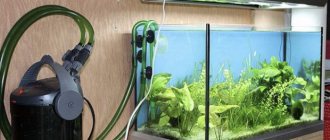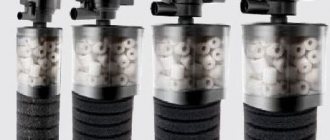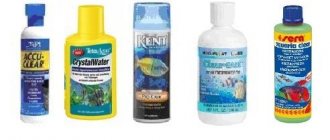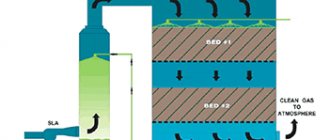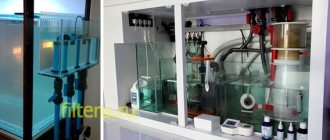An air stone is also known as an aquarium bubbler. This is one of the most important devices in any aquarium https://aqua-store.ru/. The main function of an air stone is to supply dissolved air (oxygen) into the aquarium.
Air stones are usually made from porous stone or linden wood. These small, inexpensive devices effectively disperse air into the water and eliminate noise. They also prevent the formation of large bubbles that are common in most traditional air filtration systems.
How do aquarium air stones work?
The water in the aquarium needs to circulate, and that's what an air stone does. When an air stone is attached to a pump on the outside of the tank, it begins to produce tiny bubbles.
Over the course of a few seconds, those tiny bubbles that are filled with oxygen will gradually fill the tank. The bubbles formed in the air stone not only fill the reservoir with oxygen, but also help the water circulate.
As the bubbles rise to the surface, the water near the substrate rises to the top. As this process continues to repeat, the water in the aquarium is circulated effectively.
Overview of methods
During the development of aquariums, many methods have been invented to force the supply of oxygen into the water column, and this is very convenient - every aquarist has the opportunity to choose the best aeration option for himself, which would be both cost-effective and quite effective. Globally, all methods of aeration are divided into two large groups - natural and artificial.
Natural
You don’t have to invent anything at all with special equipment, but instead bring the conditions in the aquarium as close as possible to the conditions of a natural reservoir. An aerator would create the same waves, but this is a technique, and without technical devices, the oxygen level can only be increased by planting additional plants. Dense thickets with a relatively small number of inhabitants will help you get by even without any aerators, but you must be sure that your pets do not suffer from a lack of vital gas.
An indicator of the amount of the latter can be snails , which many experienced aquarists breed specifically for this purpose. Unlike fish, these not the most mobile creatures clearly demonstrate whether everything is in order with oxygen levels. They instinctively know that there should be more oxygen in the upper layers than near the bottom, and when oxygen starvation is brewing, they try to move as high as possible - they climb plants and the walls of the container. In a normally aerated reservoir, they would never do this, because their typical habitat is the bottom.
Artificial
For those who do not want to tinker with plants and snails or are simply not sure that this will be enough, there is special equipment in the form of devices that provide aeration in one way or another. There are so many options for organizing the process that you can’t figure it out right away, so we’ll briefly consider them all.
- Compressor. This mechanism, under pressure, pumps air bubbles under the water, causing the liquid to bubble characteristically. Such a device is quite efficient, but its operation cannot be called silent, which is why many novice aquarists consider it possible to turn off the unit at least at night. It is categorically not recommended to do this, since we have already mentioned above that in the dark, plants also begin to consume oxygen, which means that there is very little of it left for the fish.
When choosing a compressor, you must either accept constant bubbling or install the aquarium away from your sleeping areas.
- Sprayers . Typically, such a device is an integral part of the compressor with which it works in tandem, being its attachment. It is necessary to install the sprayers into the ground - thanks to this, air bubbles are pumped to the very bottom and float to the surface for as long as possible. Due to this, the highest efficiency of gas dissolution in liquid is achieved. The sprayers are connected to the compressor using hoses and connectors; it is wise to scatter them over the entire area of the aquarium to make aeration as productive as possible.
- Soil filter. This unit is an alternative to a compressor, since it provides a similar effect using a fundamentally different method. If a compressor pumps oxygen deep into a reservoir, the filter constantly mixes the water flows, creating a current. Due to this, the top layer, saturated with oxygen, goes to the bottom, and oxygen-poor water comes in its place, which greatly accelerates the aeration process.
- Water pump. This complex unit combines the operating principles of both a compressor and a ground filter - it mixes the water and pumps oxygen into it under pressure, passing it directly through the current. The pump can be called “heavy artillery”; it shows the highest efficiency, but at the same time its throughput should not be less than a third of the volume of the aquarium.
- Hydrogen peroxide. You can organize aeration, and urgently, even without electricity - just add hydrogen peroxide to the aquarium. No matter how much you use this liquid, the dosage will always be calculated correctly, since this substance is harmless - in the aquarium it breaks down into the same water and oxygen that we need. Peroxide is usually used either to combat harmful algae growing in conditions of poor aeration, or for urgent resuscitation of fish after oxygen starvation.
- Oxygen tablets. This is another solution that allows you to quickly increase the oxygen level in an artificial reservoir without any electricity. Unlike hydrogen peroxide, this remedy is considered not only a method of resuscitation, but also a solution to the problem when it is not possible to use an electrical device, for example, when transporting fish somewhere. As a rule, one tablet contains 30 mg of oxygen. Considering that the norm is 5-6 mg per liter, one tablet is enough for 5-6 liters of water, which contains no useful gas at all.
- Oxidants . These are the simplest devices that work solely through chemical processes, without the need for power. Essentially, this is a special container into which the already mentioned hydrogen peroxide is poured and chemical catalysts are added, due to which the peroxide begins to decompose into water and oxygen even faster. A special feature of the device is that it does not allow peroxide as such into the water, releasing only its breakdown products - some particularly sensitive fish still do not like this substance.
- Manual compressor . This mechanism is an analogue of an electric compressor, but it operates purely from the work of human hands. Essentially, this is a hollow bulb with two holes - one is located close to it and lets air in, and a hose is attached to the other, thanks to which air will be pumped directly into the aquarium by squeezing the bulb with your hand. This is another method often used when transporting and selling fish, which is especially popular because the necessary equipment is made by “traditional craftsmen” from scrap materials.
It should be noted that the effectiveness of aquarium aeration also depends on how much attention you pay to the proper functioning of your home ecosystem.
We have already talked about the benefits of plants (and their potential harm at night), but the influence of “unusual” factors does not end there. For example, too warm water is always poorer in oxygen than cool water. This is due to the interdependence of environmental temperature and metabolism in any living organism - in warmth, all life processes occur faster, which means that more oxygen is consumed in the same amount of time. You can indirectly influence the degree of aeration by maintaining the correct temperature, although, of course, you should not get carried away with this method, otherwise your tropical pets will simply freeze.
In addition, it is important to promptly clean the aquarium from the remains of old food and regularly change the water to reduce its contamination with fish waste.
We mentioned above that the breakdown of the latter is carried out by beneficial aerobic bacteria, the vital activity of which requires air. The ideal conditions for the reproduction of these microorganisms, created in an unkempt aquarium, lead to the fact that the beneficial becomes harmful - the growing population begins to compete with your pets for the vital gas and the question is who will win without outside intervention.
Benefits of air stones in an aquarium
You can tell that the water in your aquarium is not circulating properly just by looking at its surface. If you notice that the surface of the water is still, you can be sure that the water is not circulating enough.
To better understand the benefits of an air stone, we need to first understand the benefits of water movement in an aquarium. Here are some of the benefits:
Helps in gas exchange
Imagine that the circulation of water in an aquarium is like a soft, cool breeze in a small, stuffy room. When water circulates well, dissolved gases are quickly exchanged. For example, water along with dissolved gases at the bottom of a tank remains unchanged when there is no movement of water.
In addition, fish and other organisms in the aquarium produce carbon dioxide, methane and nitrogen. These gases must be released into the atmosphere.
Moving water carries tiny bubbles of oxygen and transports these unwanted gases, carrying them to the surface of the water and releasing them into the atmosphere. In addition, the movement of water mixes different layers of water. This can be very beneficial for fish.
We know that the water at the bottom of an aquarium depletes over time, since fish primarily live on the bottom. Water that is low in oxygen is carried to the surface, and the water above, which is rich in oxygen, is circulated.
Physical activity.
In small environments, such as small aquariums, fish do not have enough space to actively swim and their movements are somewhat restricted.
However, with adequate water circulation, they get the required amount of physical activity needed for their growth and muscle development. The circulation of the water offers a little resistance and this can be very beneficial for the fish.
Better filtration.
As mentioned earlier, the movement of water helps in removing gases such as methane, nitrogen and sulfur into the atmosphere. As more oxygen is pumped into the aquarium, biological filtration becomes more effective because the movement of water prevents toxic waste from settling to the bottom.
Without proper water circulation, corals will accumulate toxins, metabolic waste, mucus, and other such organic waste. As a result, the reef's filtration becomes difficult and the water quickly becomes cloudy.
Now that we've learned all about water circulation, you may have already realized how important an air stone is. Let's find out more.
Types of aquarium internal filters
Devices can be divided according to their filtering capabilities. The simplest glasses carry out only mechanical cleaning of the water and partly biological. Accordingly, they are the cheapest.
In some models, the number of sections for installing filter material is increased, which also allows for chemical water purification using activated carbon or zeolite.
Internal filters also differ in their performance, that is, in the volume of water that is pumped through the system per unit of time. It should be noted right away that a 300-liter capacity is the fundamental limit for the technical devices under consideration.
As a rule, the pump on the internal purifier is attached to the top of the glass, but there are models where it is located at the bottom.
There are modern devices that have additional options, for example:
- built-in water heater to maintain the temperature in the aquarium;
- injector for supplying air with water;
- pump power regulator and indicator;
- flow direction switch and others.
Of course, additional devices and options are reflected in the price of the device.
Advantages of internal filters:
- Low cost internal filter. Moreover, even the brand of the manufacturer is not of fundamental importance (unless, of course, you go to extremes and buy all kinds of “soap boxes” made in Asia, when they write only numbers on the box, but in reality it turns out that everything must be divided by 2 or 3 ). The most important criterion when choosing a filter is its productivity in liters per hour, which is determined based on the capacity of the existing aquarium. Productivity must be at least 3 volumes per hour. It’s still better to have 5 volumes.2. Relatively high performance. This refers to the amount of water passed through in liters per hour, and not the incomprehensible value of “biofiltration efficiency”;
- Safety. Water can only flow into the aquarium. And only to the aquarium. If the filter stops for one reason or another, there will be no flood.
- Easy to maintain internal filter. This statement, however, is not true for all brands of filters. Maintenance mainly consists of weekly washing of the filter material in a separate container with aquarium(!) water and, somewhat less frequently, washing of the rubbing (rotating) parts of the internal filter;
- Low noise level. This is not true for all brands of filters. As a rule, with a decrease in water flow (almost all filters have this feature), the noise level decreases. Therefore, it makes a certain sense to purchase a power filter that is slightly larger than necessary;
- Possibility of simultaneous aeration of aquarium water. This “service” is available in almost all internal filters. It should not be overused, since in some types of internal filters the air supply is coupled with the distillation of water: the more the air supply valve is open, the less water passes through the filter. In addition, when the air valve is fully opened, the air bubbles become very large, which significantly reduces the process of oxygen dissolution in water. The most convenient and effective is still the purchase of a separate unit - an air compressor;
Disadvantages of internal filters:
- Small volume of filter material and, as a result, small area for the settlement of beneficial bacteria. Here it should be specifically noted that in order to increase the efficiency of the filter in terms of biological water purification, it is incorrect to increase the flow rate through the filter element, since in this case a significant part of the bacteria is simply washed out with water. In the depth of aquarium water, the benefits of bacteria are small. In addition, it has been empirically proven that the beneficial properties of bacteria are fully manifested only at a certain speed of water flow. Those. There is only one way to increase the number of a bacterial colony - by increasing the area for its settlement, which ultimately involuntarily brings us back to the use of a remote filter with a large volume of filter material;
- Occupies useful volume of the aquarium. In fact, this occupied volume is negligible - usually no more than a few percent of the total volume of the aquarium;
- Large load on the filter element (mechanical and biological cleaning at the same time). Part of the surface of the filter element, on which it would be desirable to settle more aerobic bacteria, will simply become clogged with dirt. And during the weekly sponge wash, some of the beneficial bacteria will be washed out along with the dirt. Due to the above, a change in the number of beneficial bacteria will each time lead to some, albeit insignificant, but still instability of the biological environment in the aquarium. Therefore, you should not clean your sponge with the fury of a housewife. Try to perform this operation ... with the carelessness of an employee;
- Lack of possibility of chemical water purification. Activated carbon is usually used for chemical water purification. In fact, chemical cleaning is not mandatory in every aquarium. But occasionally the fish still get sick and medicines have to be added to the water. After a course of treatment, it is necessary to remove the remaining drugs from the aquarium, and coal is simply irreplaceable here. Therefore, it is better to purchase an internal filter with at least one additional section for possible filling with carbon.
- The aesthetic side is lame. An uncovered box of “foreign flowers” is unlikely to complement the biotope you have built. But this disadvantage can be easily eliminated - just cover the foreign object with something, for example, a beautiful piece of driftwood.
Do I need an air stone?
If you are asking yourself this question, remember the example of a fresh wind and a stuffy room that we mentioned above. The answer is absolute: yes, it doesn't matter whether you have a filter in your aquarium or not, attaching an air stone greatly improves water circulation.
Installing an air stone will keep the water cleaner, provide more oxygen to the fish, and generally provide many health benefits to aquatic life. Also, an air stone is not very expensive and will not cause much damage to your budget.
Plastic nozzle
Plastic nozzles for aerators are produced mainly in China. The cheapest sprayers are made of low-quality plastic and therefore release toxic substances into the water. Water poisoning can also occur due to the dissolution of low-quality glue.
Expensive plastic nozzles are made of high-quality material, so they do not release harmful substances into the water. The flow of air into an aquarium with such attachments is very weak due to the design.
If you are using these nozzles to aerate a large volume of water, increase the rotation speed of the aerator motor to ensure sufficient air pressure.
It is better to use silicone hoses with such nozzles, as they are flexible and can withstand high air pressure.
What types of air stones are there?
Air stones are sold in different shapes and sizes. Although all air stones are designed for the same purpose, some may be better suited to a certain type of aquarium. In other words, not all air stones are ideal for all types of aquariums. Here are the types of air stones you can choose from.
Silica
This type of air stones is the most common. They are available in various sizes from 2.5 to 30 cm. This type of air stones is mainly used in laboratories for research. Silica-based air stones contain no metals and are less expensive. Their only drawback is that they are not very durable.
Aluminium oxide
There is not much difference between silica and alumina stones in terms of performance. But when it comes to durability, aluminum oxide stones are the best option. These stones can withstand years of use and harsh cleaning. These stones are mainly used in industrial or large water bodies.
Aluminum oxide stones are not recommended for use in glass aquariums due to their rough surface. They can vibrate and scratch the glass, leading to cracks over time.
Which filter is better?
Perhaps no aquarist can give a definite answer to this question. There are quite a lot of models on the market that have been successfully used for a long period.
Sera
If we consider the problem from the point of view of the price for the device, then among the economy-class internal purifiers we can highlight the products of the German company Sera.
Inexpensive devices of this brand L30, L60, L120, L150 and even L300 are easy to use and reliable. The numbers indicate the volume of the aquarium for which they are intended.
Fluval
Italian devices from the Fluval brand are long-lived in the aquarium accessories market. The best-selling device in the line of Italian models is Fluval4 Plus. It has a strong pump, flow power indicator and a modern, eye-catching design.
However, this model has relatively large dimensions, and its filter elements quickly become clogged. According to the stated design features, the filter cartridge can be changed without stopping the operation of the device and without removing it from the water.
But in fact, during this operation, some of the garbage still ends up back into the water. It is better to turn off the device for a while and calmly change the cartridge.
AquaEl FAN
Polish-made AquaEl FAN internal aquarium cleaners have become very popular. And completely justified. Having low energy consumption with a relatively powerful pump, Polish devices are reliable, simple, and effective.
They compare favorably with their Chinese and some European counterparts in the original filter material (phenol-free sponge), on which bacteria actively settle, ensuring high-quality processing of organic residues and nitrogen compounds.
According to aquarists, AquaEl FAN has only one drawback - increased noise level when working with aeration.
Eheim
Eheim brand internal filter devices can be called the elite of this type of device. The designers of the German company Eheim GmbH & Co meticulously and creatively approached the problem of creating a unified filter.
For example, the Eheim 2212 AquaBall model has an original outlet pipe design. Like a joystick, it can be rotated in any direction using a ball design. This is very convenient, since the flow of water and air bubbles can even be directed downward.
The devices are almost silent, the filter sections in the glass can be swapped, and standard biofillers do an excellent job of their biological purification function.
The devices under consideration, which are the most expensive in their class, have only one drawback - the axis of the pump impeller is ceramic (in all other models it is metal). Therefore, special care must be taken when disassembling and servicing such a filter.
The variety of aqua filters that work inside an aquarium is great. Which one is better? Perhaps one that meets the requirements of reliability, functionality, efficiency and is suitable for an aquarium of a specific capacity.


